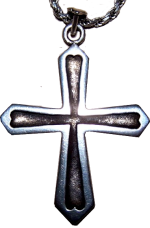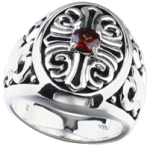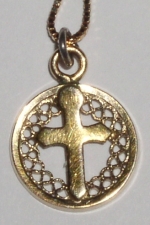Passion Cross and Nail Cross
also known as the Cross of Suffering,
Carpenter's, Pointed, Aiguisé, Urdée or Urdy cross
The common understanding is that Jesus Christ was nailed to the cross. But were nails actually used? On this page we discover the true meaning of passion.
The first two examples on the left show four points. The upper three short members represent the three nails, and the lower pointed stem represents the spear that pierced Jesus' side.
The next example shows three nails (one for each hand and one for nailing both feet together) and a halo on the upper part. This image was copied from a photo, kindly sent to us, of a pendant which features a composite Passion Cross and Sun Cross.
The French word for 'sharpened' is aiguisé and in heraldry called the Cross Aiguisé or Pointed Cross. Another heraldic name is the Cross Urdée (Urde, or Urdy). Urde means a 'sharp projection', like a spearhead. The plural of urde is urdee and this is sometimes used to describe the pointed battlements of a fortress. In addition to heraldry, this cross is used as a typographical mark called the obelisk.
This website includes pages about weddings so it's not surprising that we mention the word 'passion' from time to time. However, the sultry, glowing, ardent love definition of passion is not the original meaning. The word comes from the Latin passio, which means suffering or enduring. The use was extended to the sufferings of martyrs, and from there to strong emotion, and finally to today's popular use to describe a burning desire.
The Passion Cross is named from the original meaning and refers to Christ's suffering on the cross – not just the obvious physical pain, nor from the mocking crowd, the humiliating crown of thorns, sign and robe. (See also Arms of Christ.) The real and immeasurable suffering was paying for our sins. (See Mark 14 and Mark 15.)
The plain design of the Passion Cross makes it suitable for heraldry and easy to print or draw. An alternative name is the Nail Cross (see also Disciple's Cross) which has exactly the same meaning but is visually more representational. (Matt. 13:55 and Mark 6:2-3 imply Jesus was a carpenter, consequently the Nail Cross is sometimes referred to as the Carpenter's Cross. See also Pincers Cross)

The Nail Cross may show three, or four, nails.
Which is correct?
Hands
Is it possible that Jesus was not nailed to the cross, but rather was bound with rope, the way the thieves are often depicted? After all, nails are not mentioned in any description of the Crucifixion in the Gospels.
Which would be more tortuous? The searing pain of nails that would hasten death through shock, or the binding by rope that would prolong the agony?
We do read, however, that after Christ's Resurrection Thomas demands to see the nail marks in Jesus' hands, and this gives us a written record of nails being used (John 20:25).
Many paintings show nails through the palms but this defies logic and reason. If someone were hung by spikes through the palms of the hands, the weight of the body would simply tear the flesh away any the victim would fall. More likely that spikes were positioned through the wrist (between the radial and ulna) or between bones in the forearm.
Yet here, in John 20:24-31 we read that the nail holes were in the hands. This means either that there is a misunderstanding in the Bible's translation (early anatomists considered the 'hand' included the wrist) or that the arms were bound to the cross with rope, and nails were driven through the palms to increase the agony.
Feet
Early crucifixion scenes show the feet dangling, without nails, but this also defies reason. Without securing the legs or feet to the cross, the weight of the body would drag the torso down so much that the chest would be unable to expand and contract, respiration would be impeded and the victim would quickly suffocate to death.
To prolong the agony, the feet must be attached. And in Ps. 22:16 we read that both hands and feet are pierced.
So it's reasonable to assume that three or four nails were used in Jesus' Crucifixion. (Helena is reported to have recovered three nails when she found the True Cross, but of course, she might have missed a fourth one.) In any case, the difference is perhaps not worth debating much – if both feet were nailed together with one nail, or the feet were nailed separately with two nails, the suffering would be about the same. Truly dreadful.
But how does this suffering of Jesus pay for our sins? See the meaning of the Cross and also read Willing Suffering by Rev. David Linde.
 | Sterling silver Passion Cross, slightly tapered and rebated with a budded cross (Click photo to enlarge) |
 | Passion Cross with four Serbian C's on a garnet signet ring |
In heraldry, an aiguisé is defined as having sharp pointed arms where the taper begins near the end of the arm, This differs from the fichée, where the tapering begins further from the arm end.
Urd is the Norse equivalent of the Greek god of Fate and this may have an etymological connection with the spearhead-shape.




